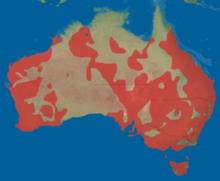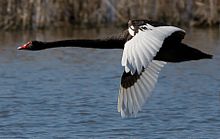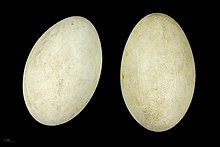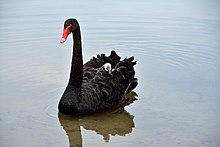Black Swan
| Black Swan | ||||||||||||
|---|---|---|---|---|---|---|---|---|---|---|---|---|

Black Swan ( Cygnus atratus ) |
||||||||||||
| Systematics | ||||||||||||
|
||||||||||||
| Scientific name | ||||||||||||
| Cygnus atratus | ||||||||||||
| ( Latham , 1790) |

The Trauerschwan ( Cygnus atratus ) or black swan is a bird species in the genus of swans ( Cygnus ), and the family of the Anatidae (Anatidae). It is the only almost completely black swan and also has the longest neck of all swans.
The natural range of the black swan is Australia, in New Zealand the black swan is naturalized. In Europe there are only exposed and feral Black Swans. A self-sustaining population, which comprised sixty to seventy breeding pairs in the year 2000, only exists in the Netherlands and possibly also in North Rhine-Westphalia. The total population of the Black Swan is estimated by the IUCN at 100,000 to one million sexually mature individuals. The species is not considered endangered.
Appearance
When fully grown, black swans reach a body length of 110 to 140 centimeters and are therefore slightly smaller than the mute swan . In flight , the neck makes up over half of the total length. The wingspan is between 160 and 200 centimeters. Males weigh an average of six kilograms, while females weigh five. There is no pronounced sexual dimorphism , the females are just slightly smaller and have a slightly shorter neck and beak in proportion to their body size. Old males stand out for their stronger and longer necks, thicker due to the curling of their feathers, and their more intensely colored irises.
Through her about 31 cervical vertebrae mourning swans can also in deeper waters gründeln . The plumage is black. The feet are anthracite-colored with black claws. Only the wing feathers are white in color, but they are almost always hidden in the plumage and are very clearly visible when the wings are open or in flight. The animals have curly feathers on the edges of their wings. The beak is colored bright red and is adorned with a white band near the tip of the beak. The eye color varies from orange and light brown to black.
The downy chicks are solid dark silver-gray. Their beak and legs are dark gray and the iris is grayish brown. The chicks show their first shoulder feathers at the age of 55 days. At the age of 75 to 95 days, the small plumage is largely developed. The wings have reached their full length after five to six months. With the exception of the white wings, young birds have dark, matt gray-brown plumage. The beak is pale red in them, the light transverse band is only hinted at. The iris is brown and the legs are gray. Due to the lack of curling of the feathers, the necks of young birds in their first annual dress appear particularly thin. The change of color to the old age dress takes place between the 8th and 26th month of life. On average the males are colored after their 13th month of life and the females after their 12th month. The moult usually takes three to four months.
Grief swans need like mute swans a long start-up period before they can rise into the air. They usually need forty to fifty meters and are therefore dependent on large open water areas with little swell. Once they are up in the air, their wings beat slowly and powerfully.
voice
Mourning swans use their voices, among other things, to loudly greet each other, combined with moving their heads up and down, which is known as "bobbing". They also swim in the middle of a lake, put their long necks on the water and “trumpet” audibly over the water, for example to call for a conspecific or simply to express their displeasure. In contrast, the Mute Swan has a much less loud voice.
distribution
The black swan is the heraldic animal of Western Australia and is represented there in the flag. It is now found in all states of Australia , on the mainland as well as in Tasmania . Humans play a major role in its current distribution. When Europeans first observed it in the area around present-day Perth in 1697, it was not frequent in this region. Docked Black Swans were deliberately resettled by authorities in this region around 1890 and it is only since then that larger numbers have been observed in southwestern Western Australia. The first observations in the Northern Territory date from 1923 and only in 1966/1967 did weeping swans breed there.
A subspecies of the black swan, the New Zealand swan ( Cygnus atratus sumnerensis ), lived in New Zealand and the Chatham Islands . Their extinction is believed to be due to intensive egg-collecting during the breeding season and hunting by the Māori during the moult. In the mid-19th century, weeping swans from Australia were naturalized in New Zealand, where they have since become firmly established. Around 100 Black Swans were naturalized on the South Island between 1864 and 1886. The spread was so rapid that weeping swans were observed on the Chatham Islands as early as 1922. It is therefore believed that during these decades wild mourning swans also reached New Zealand from Australia. The main area of distribution of the black swans in New Zealand is Lake Ellesmere , where 70,000 individuals were counted in 1968. To reduce the number of black swans there, they were shot and their eggs were collected. In 1968 there were severe storms in this region, in which numerous mourning swans were killed and the vegetation of the lake was so severely disturbed that the number of swans had dropped to 7,000 individuals in 1980.
In Europe and the United States , it is occasionally kept in parks and, as a captive refugee, has occasionally brooded in the wild. Sightings of black swans are repeatedly reported from Germany. For 2005, 11-18 breeding pairs were reported from Germany, which were descended from breeding animals that had escaped. For Germany, elimination (catching and shooting) is required so that no larger populations build up.
habitat
The black swan is a bird of the temperate and subtropical climatic zone. It lives in estuaries, sheltered sea bays, on floodplains and on lakes with fresh or brackish water, whereby it prefers shallow permanent water surfaces. He avoids zones with strong currents or waves and is dependent on access to fresh water. Breeding biotopes are large inland lakes with flat shore regions, coastal waters and floodplain areas. Outside the breeding season, it can also be found on rivers.
They usually live in pairs, but flocks of black swans, comprising thousands of individuals, are occasionally observed. Such large swarms can occur all year round in the entire natural range. Most often, however, they occur in undisturbed places during the moulting season. In Australia, large accumulations of this species of swan are observed, especially on brackish lakes. In New Zealand, identified birds have shown that the composition of such clusters is not static.
Way of life

In contrast to many other water birds and the other swan species, the black swan is not a migratory bird . It is extremely mobile and small disturbances such as persistent noise cause the animals to move on. In doing so, however, they remain within a radius of around 100 kilometers from their old place of residence and thus spend their entire lives in the region in which they grew up. They move around in this area only relatively small-scale in order to react to different water levels and only temporarily existing water surfaces. Young males also prevent another male Black Swan from settling in their territory; the animals prefer to avoid each other. In pronounced dry seasons they are concentrated in Australia on the coast in protected lagoons and bays.
nutrition
Black swans feed mainly on aquatic plants and algae , but they also like to eat grains such as wheat or corn. They also like to pluck the leaves of weeping willows hanging in the water or grass near the bank.
Reproduction
The breeding season changes from area to area and adapts to seasons with high water levels. In Germany, weeping swans sometimes show their old Australian rhythm and breed, often with success, in winter. In places where there are many black swans, only a small part of the birds present breed. Of the 2,000 to 3,000 black swans that congregated on Lake George in 1963, only about 400 pairs brooded. In New Zealand it has been observed that only one in five swans brood each year and that no more than a third try to build a nest at the breeding grounds. It is presumed that either the beginning of the reproductive phase is delayed for a long time or that mourning swans that have already successfully reared eggs do not brood every year.
Black swans usually breed in colonies. They build a large nest mound, which is usually in the middle of a shallow body of water. They reuse the same nest every year and only repair it as much as is necessary. Like other swans, this species is strictly monogamous. Both parent birds are involved in nest building and take care of the young.
The female lays four to eight pale green eggs . The eggs are incubated by both parents alternately for five or six weeks, depending on the weather. Males tend to be poor breeders because they like to forget to regularly turn and turn the eggs or accidentally lay next to the eggs. Investigations on mourning swans kept in human care showed very different breeding behavior. There were both single males and single females who reared a brood on their own after the other partner bird had left them, there were also pair constellations in which the male and female parent bird shared the care for the young birds, as well as homosexual pairings, which occasionally Raised clutches from which they drove the actual parent birds away.
Fledglings can fledge after about five months. Sexual maturity occurs at two and a half to three years of age, after which the males become extremely aggressive and aggressive, especially in captivity.
attitude
The first black swans were introduced in Great Britain in 1791 and shortly afterwards also in France. The first breeding succeeded in 1837 at the London zoo, from 1850, weeping swans were also successfully bred in Germany and France. The first successes in breeding were in the United States of North America in 1909. Targeted reintroduction attempts were made very early in England, but they did not lead to population formation. They are usually displaced by mute swans, which have higher reproduction rates. Only in the last few decades has a feral population been observed, which originated in the Netherlands. In Europe, the main laying seasons are early spring to May and August to winter.
Cultural meaning
- Metaphor and mythology: the image of the “black swan” as a completely unexpected event goes back to the satirist Juvenal . In Satires VI, 161 he names a faithful wife rara avis in terris, nigroque simillima cygno (a rare bird in all countries, most like a black swan). Black swans were unknown in Europe at that time. In the following, Juvenal (Satiren VII, 202) also speaks of the “white raven”: Felix illegally tamen corvo quoque rarior albo (such a lucky guy is rarer than a white raven).
- The black swan is the official heraldic animal of the Australian state of Western Australia and is depicted in its national flag.
- A famous representative of the species is the mourning swan, christened “ Petra ”, who believed to have found his partner in a white swan-shaped pedal boat on the Aasee in Münster from 2006 to 2008. In Germany, only an estimated 50 specimens live in freedom and are scattered all over the country.
supporting documents
literature
- Hans-Günther Bauer, Einhard Bezzel and Wolfgang Fiedler (eds.): The compendium of birds in Central Europe: Everything about biology, endangerment and protection. Volume 1: Nonpasseriformes - non-sparrow birds. Aula-Verlag Wiebelsheim, Wiesbaden 2005, ISBN 3-89104-647-2 .
- PJ Higgins (eds.): Handbook of Australian, New Zealand & Antarctic Bird , Volume 1, Ratites to Ducks, Oxford University Press, Oxford 1990, ISBN 0-19-553068-3
- Hartmut Kolbe: The world's ducks. Ulmer Verlag 1999, ISBN 3-8001-7442-1
Web links
- Cygnus atratus in the endangered Red List species the IUCN 2008. Posted by: BirdLife International, 2008. Accessed January 31 of 2009.
- Videos, photos and sound recordings of Cygnus atratus in the Internet Bird Collection
- Feathers of the black swan
Single receipts
- ↑ a b Bauer et al., P. 39
- ↑ BirdLife Factsheet on the Black Swan , accessed April 10, 2011
- ↑ a b c Higgins, p. 1.178
- ↑ Kolbe, S: 93
- ^ Kolbe, p. 93 and p. 94
- ↑ a b Kolbe, p. 93
- ↑ a b c Higgins, p. 1.179
- ↑ Higgins, p. 1.180
- ↑ Klemens Steiof: Action requirements in dealing with non-native and invasive bird species in Germany . Reports on bird protection 47/48, 2011: 93-118.
- ↑ a b Higgins, p. 1.181
- ↑ Higgins, pp. 1,181-1,182
- ↑ a b Kolbe, p. 94







